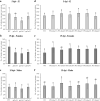The role of AtPP2-A3 and AtPP2-A8 genes encoding Nictaba-related lectin domains in the defense response of Arabidopsis thaliana to Heterodera schachtii
- PMID: 37420105
- PMCID: PMC10329053
- DOI: 10.1007/s00425-023-04196-y
The role of AtPP2-A3 and AtPP2-A8 genes encoding Nictaba-related lectin domains in the defense response of Arabidopsis thaliana to Heterodera schachtii
Abstract
Expression levels of AtPP2-A3 and AtPP2-A8 are reduced in syncytia induced by Heterodera schachtii and decline of their expression levels decreases host susceptibility, whereas their overexpression promotes susceptibility to parasite. Plant-parasitic nematodes cause huge crop losses worldwide. Heterodera schachtii is a sedentary cyst-forming nematode that induces a feeding site called a syncytium via the delivery of secreted chemical substances (effectors) to host cells, which modulate host genes expression and phytohormone regulation patterns. Genes encoding the Nictaba-related lectin domain have been found among the plant genes with downregulated expression during the development of syncytia induced by H. schachtii in Arabidopsis thaliana roots. To investigate the role of two selected Nictaba-related genes in the plant response to beet cyst nematode parasitism, mutants and plants overexpressing AtPP2-A3 or AtPP2-A8 were infected, and promoter activity and protein localization were analyzed. In wild-type plants, AtPP2-A3 and AtPP2-A8 were expressed only in roots, especially in the cortex and rhizodermis. After nematode infection, their expression was switched off in regions surrounding a developing syncytium. Astonishingly, plants overexpressing AtPP2-A3 or AtPP2-A8 were more susceptible to nematode infection than wild-type plants, whereas mutants were less susceptible. Based on these results and changes in AtPP2-A3 and AtPP2-A8 expression patterns after treatments with different stress phytohormones, we postulate that the AtPP2-A3 and AtPP2-A8 genes play important roles in the defense response to beet cyst nematode infection.
Keywords: Agglutinin; Beet cyst nematode; Phloem protein (P-protein); Plant-parasitic nematode; Plant–nematode interaction; Resistance; Susceptibility; Syncytium.
© 2023. The Author(s).
Conflict of interest statement
We declare that we have no significant competing financial, professional, or personal interests that might have influenced the performance or presentation of the work described in this manuscript.
Figures




Similar articles
-
Arabidopsis thaliana Myb59 Gene Is Involved in the Response to Heterodera schachtii Infestation, and Its Overexpression Disturbs Regular Development of Nematode-Induced Syncytia.Int J Mol Sci. 2021 Jun 16;22(12):6450. doi: 10.3390/ijms22126450. Int J Mol Sci. 2021. PMID: 34208611 Free PMC article.
-
Arabidopsis miR827 mediates post-transcriptional gene silencing of its ubiquitin E3 ligase target gene in the syncytium of the cyst nematode Heterodera schachtii to enhance susceptibility.Plant J. 2016 Oct;88(2):179-192. doi: 10.1111/tpj.13238. Epub 2016 Aug 26. Plant J. 2016. PMID: 27304416
-
The Arabidopsis bHLH25 and bHLH27 transcription factors contribute to susceptibility to the cyst nematode Heterodera schachtii.Plant J. 2011 Jan;65(2):319-28. doi: 10.1111/j.1365-313X.2010.04424.x. Plant J. 2011. PMID: 21223395
-
Syncytium Induced by Plant-Parasitic Nematodes.Results Probl Cell Differ. 2024;71:371-403. doi: 10.1007/978-3-031-37936-9_18. Results Probl Cell Differ. 2024. PMID: 37996687 Review.
-
The plant cell wall in the feeding sites of cyst nematodes.Front Plant Sci. 2014 Mar 19;5:89. doi: 10.3389/fpls.2014.00089. eCollection 2014. Front Plant Sci. 2014. PMID: 24678316 Free PMC article. Review.
Cited by
-
The crystal structure of Nictaba reveals its carbohydrate-binding properties and a new lectin dimerization mode.Glycobiology. 2024 Dec 10;34(12):cwae087. doi: 10.1093/glycob/cwae087. Glycobiology. 2024. PMID: 39437181 Free PMC article.
References
MeSH terms
Substances
Grants and funding
LinkOut - more resources
Full Text Sources

